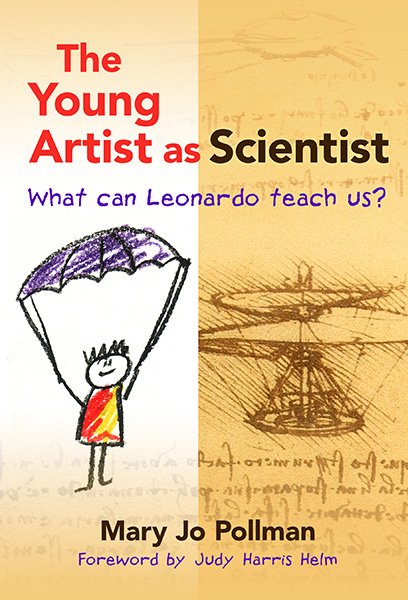Professors: Request an Exam Copy
Print copies available for US orders only. For orders outside the US, see our international distributors.
Foreword by: Judy Harris Helm
Publication Date: September 8, 2017
Pages: 208

This is the first in-depth look at the important connections between the arts and science specifically for early childhood education (pre-K–3rd grade). Highlighting their many commonalities, such as the processes involved in creative problem solving, the author draws on what we can learn from Leonardo da Vinci as the supreme artist-scientist. Every chapter begins with a vignette of Leonardo and relates his thinking to the development of children’s ideas in the arts and STEM (STEAM). This fresh look at the interdisciplinary connections of the arts and science offers early childhood teachers and administrators a spectrum of tools for connecting the creative arts (art, movement, drama, and music) to the STEM movement, 21st-century skills, and developmentally appropriate practice.
Book Features:
Mary Jo Pollman is professor emerita of early childhood education at Metropolitan State University of Denver and Arts–STEM enrichment specialist.
“Readers will enjoy the useful index, recommended resources, and Pollman's strategy of introducing each section with experiences from the life and time of Leonardo DaVinci that creatively draw the reader into practical understanding and application of the arts in science education.”
—Science and Children
“Mary Jo Pollman presents a coherent, well-researched argument for replacing meaningless activities with engaging creative art and STEM experiences, which have the potential to become cohesive, integrated adventures in learning.”
—From the Foreword by Judy Harris Helm, president, Best Practices, Inc., author of Young Investigators, The Project Approach in the Early Years, Third Edition
“Mary Jo has written for individuals who influence what happens in early childhood classrooms, and she understands the many connections between science and art. Her illustrative material and resources foster creativity and science learning with ready-to-use activities. The world is changing much faster now, and The Young Artist as Scientist arrives at the dawning of a new Renaissance in early childhood education!”
—Carrie Lynne Draper, founder & executive director, Readiness Learning Associates
“At a time when early elementary curriculum is becoming increasingly narrow in focus, this timely book builds a compelling case for the importance of the arts, including how the arts align with, undergird, and support science, technology, engineering, and math. Woven throughout the book are historical perspectives, current research, critical concepts, and activity ideas that provide a rich rationale and immediate applicability to the classroom.”
—Julie Bullard, University of Montana
Foreword by Judy Harris Helm
Preface
Acknowledgments
PART I: FOUNDATIONS OF THE ARTS–STEM CONNECTION
Chapter 1. A Model for Application of Arts–STEM in Early Childhood Education
Leonardo da Vinci: The Artist Who Became a Scientist
The Arts: A Catalyst for 21st Century Skills, STEM, and Developmentally Appropriate Practice
How Are the Creative Arts Connected to STEM?
How Are the Next Generation Science Standards Connected to the Arts?
The Project Approach: Teaching Strategy for Arts–STEM Connections
Summary
Review and Reflect
Chapter 2. Creativity: The Propeller for Arts–STEM
The Development of Creativity in Leonardo da Vinci
Issues Related to Creativity
Cultural Importance of Creativity
Foundational Concepts About Creativity in Young Children
Summary
Review and Reflect
Chapter 3. Building a Creative Ecosystem in the Classroom
A Creative Ecosystem: Florence During the Time of Leonardo da Vinci
Conditions of a Creative Ecosystem in the Classroom
Forces in the Learning Environment: Climate, Space, and Time
Blockades to Creativity
Summary
Review and Reflect
PART II: THE ARTS AND THEIR RELATION TO STEM
Chapter 4. Creative Movement and Drama: Their Importance for Math and Science
The Engagement of Leonardo da Vinci in Creative Movement and Drama
Understanding the Importance of Creative Movement
Defining Creative Movement
Integrating Creative Movement into the Content Areas
Exploring Creative Drama and Connections to STEM
Summary
Review and Reflect
Chapter 5. Collaborative Interaction with Art Media Using 21st Century Skills
How Leonardo da Vinci and His Contemporaries Understood the Science and Invention of Painting
Reggio Emilia: Opening New Vistas for Collaborative Relationships
Origins and Use of Media
Two-Dimensional Forms of Artistic Expression and Connections to Science and Technology
Three-Dimensional Forms of Artistic Expression and Connections to Science and Technology
Electronic Forms of Artistic Expression
Integrating the Elements of Art into STEM and Other Areas: A Field Trip to the Zoo
Summary
Review and Reflect
Chapter 6. The Elements of Art and the Principles of Design: Their Importance to STEM
How Leonardo da Vinci Thought About Art and Design
Opening Channels to Support Design–STEM Connection
Defining the Elements of Art
Understanding the Principles of Design
Integrating the Elements of Art and the Principles of Design into STEM
Summary
Review and Reflect
Chapter 7. Music: A Catalyst for Math and the Science of Sound
The Importance of Music in the Life of Leonardo da Vinci
Opening Vistas of Support for Music–STEM Connections
Defining the Elements of Music
Musical Experiences in Early Childhood
Exploring and Integrating Music into the STEM Curriculum
Summary
Review and Reflect
Conclusion: Collaboration for Creativity—A Plan of Action for Arts–STEM
Thinking and Acting Like Leonardo da Vinci
Exploring Methods for Educators to Promote the Arts–STEM Connection
Recommendations for Preservice and Inservice Education Programs to Enhance Creativity in Arts–STEM
Recommendations Related to the Community and Parents
Summary
Review and Reflect
References
Index
About the Author
Professors: Request an Exam Copy
Print copies available for US orders only. For orders outside the US, see our international distributors.